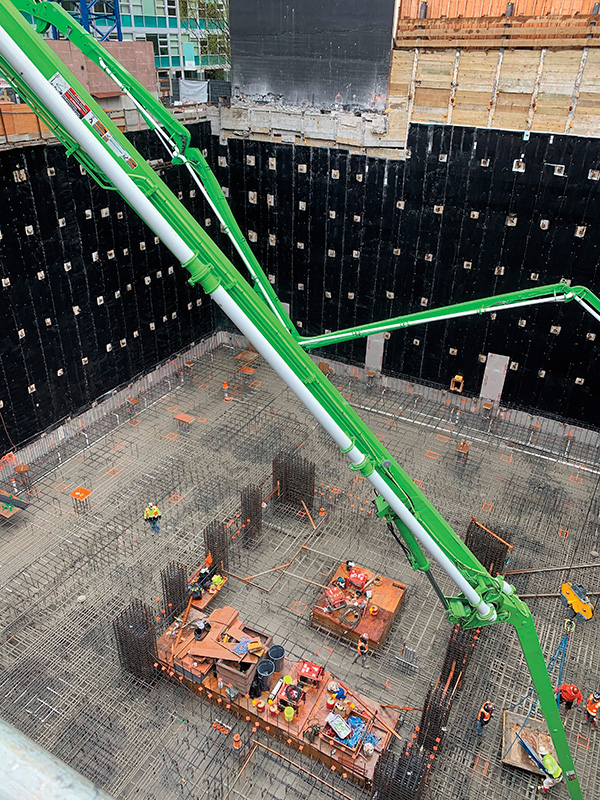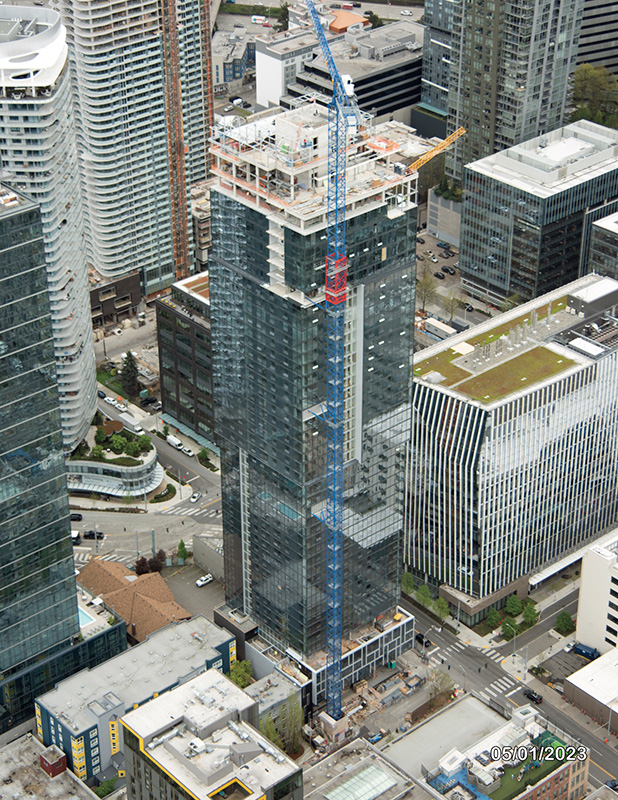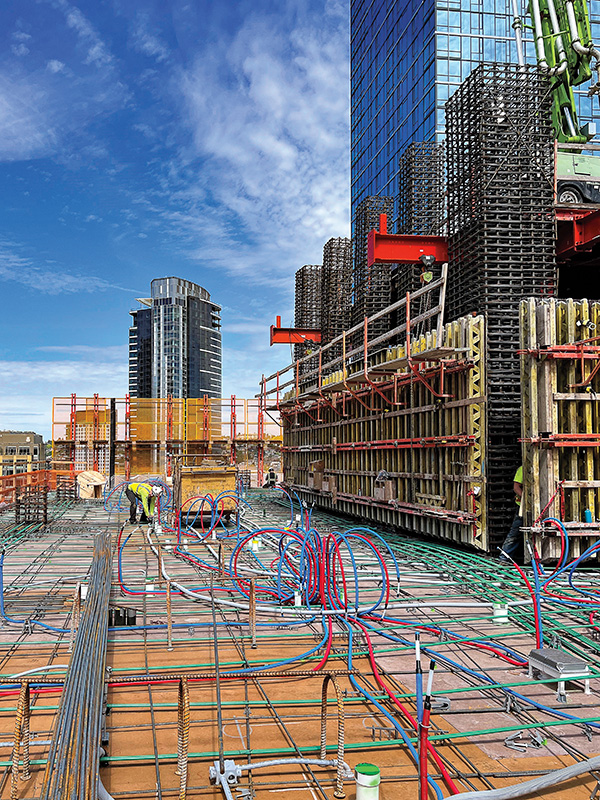According to the World Meteorological Association, 2011-2020 was the warmest decade on record. The current decade is expected to be even warmer. Climate change is real; excess atmospheric carbon is a primary cause, and reducing it is the responsibility of all. That includes structural engineers, who can play a key role in reducing the carbon footprint of buildings and other structures.
The contribution of structural engineers to sustainability can be twofold. The first is by participating in ongoing initiatives to reduce the carbon footprint of structural materials. Structural engineers can play a valuable role in these initiatives by developing an awareness and understanding of new carbon-favorable materials and specifying them when and where feasible. Many new materials and processes that can reduce embodied carbon are incubating around the globe, waiting only for the specifier’s pen to put them in play.
The second, equally important, and more directly controlled contribution of structural engineers to embodied carbon reduction is in creating efficient designs that optimize structural material quantities and allow the productivity potential of modern construction systems to be fully realized. Reducing embodied carbon arguably begins with a materially efficient design that responds to the realities of construction. Efficient material use plus simplified construction equals carbon reduction. Structural engineers who understand and execute this will lead the sustainability initiative.

This article will discuss several tactics for each of those two strategies for reducing the carbon footprint of structural designs. And since concrete has been a focus of recent sustainability initiatives due to its significant carbon footprint, this article will focus on that material.
Portland Limestone Cement
Concrete is the world’s most widely used construction material. It is common to all continents and all types of structures. But concrete has a major sustainability problem caused primarily by its cement binder. As limestone is heated to the extreme temperatures required to make cement, a chemical reaction emits significant carbon dioxide as the limestone transforms to clinker. About 7 percent of all excess global atmospheric carbon comes from the cement manufacturing process, making cement a primary target for carbon reduction strategies in the concrete industry.
To reduce embodied carbon in concrete projects, one option is to use Portland Limestone Cement (PLC), a material that’s beginning to dominate U.S. concrete construction. PLC, also known as Type 1- L cement, is a blended hydraulic cement that contains between 5 and 15 percent unheated limestone per ASTM C595. Increasing the unheated limestone and simultaneously reducing cement content offers comparable performance to Portland Cement while reducing PLC’s overall carbon footprint by about 10 percent.
PLC has been successfully specified on several recent projects, including The Ayer in Seattle, a 40-story luxury apartment tower currently completing construction. PLC was used in all primary mixes – foundations, columns, shear walls, and slabs – with specified concrete strengths as high as 15 ksi in lower-level columns. While there were initial difficulties in achieving specified performance, the net result of using PLC was positive throughout.
Interestingly, while PLC is only now gaining a foothold in the U.S., Europe has been experimenting with this more environmentally friendly material for over 40 years. European Standard EN197-1 includes provisions for types of cement containing unheated limestone in amounts up to 35 percent.
Limestone Calcined Clay Cement
Another new cement with even greater sustainability benefit than PLC is Limestone Calcined Clay Cement, also known as LC3. Although its use has been limited, LC3 has big potential for carbon reduction. It combines Ordinary Portland Cement (OPC), limestone, low-grade clays available in abundant quantities, and small amounts of gypsum. LC3 is cost-effective and does not require modifications to existing production equipment. Strengths achieved with LC3 mixes are equivalent to OPC mixes. Most importantly, from a sustainability perspective, LC3 reduces carbon dioxide emissions by up to 40 percent compared to mixes made with OPC.
The LC3 blend most commonly being studied is LC3-50, meaning that only 50% of the blend is OPC, with the remainder being calcined clay, limestone, and gypsum. This OPC reduction is highly important to the concrete industry’s carbon challenge since it is anticipated that the steadily diminishing availability of fly ash and blast furnace slag for use as Supplementary Cementitious Materials (SCMs) will soon require other strategies for OPC reduction.

Fortuitously, in addition to reducing the need for SCMs, the durability characteristics of LC3 are even better than mixes made with fly ash and slag, creating an opportunity for the industry to reduce its carbon footprint and simultaneously improve structural durability without the use of either of these two pozzolanic materials. LC3 mixes have higher resistance to chloride ion penetration and alkali-silica reactivity, both of which are important qualities for improving the durability of bridges, buildings, and other structures.
LC3 is a product that engineers and specifiers should investigate and ultimately embrace. Since ASTM C595 “Standard Specification for Blended Hydraulic Cements” allows an OPC clinker content as low as 45%, LC3-50 is feasible for use today.
Alternative Pozzolans
Several alternative pozzolans are entering the market, one of the more interesting being ground glass, a product made from recycled glass. First used in 1998, it is made by feeding waste glass into a grinding apparatus that feeds into an air classifier. The air classifier separates out oversize particles and sends them back to the hopper for further grinding.
Ground glass added to the concrete as a Supplementary Cementitious Material (SCM) forms a calcium silicate hydrate cementitious binder. The glass pozzolan can replace a significant percentage of the Portland Cement binder and reduce concrete’s carbon footprint by up to 50 percent. Concrete mixes that include ground glass SCM in combination with PLC can achieve a 65 percent reduction in carbon emissions.

Concrete made with ground glass SCM also meets the necessary performance criteria. It demonstrates suitable strength gain and achieves an elastic modulus equivalent to Portland Cement concrete. It exhibits unaltered creep and shrinkage properties and offers reduced chloride penetration. In 2020, glass pozzolan received an official nod from ASTM International by means of ASTM C1866/C1866M-20, a standard specification for ground-glass pozzolan for use in concrete. And while there are questions about whether ground glass pozzolan can be scaled up to meet industry demand, it nevertheless represents an interesting option for a concrete industry challenged with achieving major carbon reduction.
Carbon Capture Storage and Utilization
Concrete mixes featuring synthetic aggregates produced with captured carbon dioxide and mixes using carbon dioxide injection are also being developed. Several companies are working on using sequestered carbon emitted by industrial processes to produce coated and synthetic aggregates. Other manufacturers inject carbon dioxide from industrial partners into concrete as it is mixed. The carbon dioxide forms a nano-sized mineral, calcium carbonate, which adds strength and enables mix optimization, all while eliminating the carbon dioxide from entering the atmosphere.
Still another interesting sustainability technology is a method being pioneered for curing concrete with carbon dioxide instead of water. It promises to reduce carbon dioxide by sequestering it in concrete and significantly reduce the water quantities required for batching.

Efficient Design
Perhaps the sustainability strategy most directly under the control of structural engineers is to create materially efficient designs. Designs that are unnecessarily cumbersome, heavy, or poorly conceived pay the price in higher embodied carbon, regardless of the materials used. Conversely, projects that use structural materials in efficient ways that allow the productivity potential of modern construction systems to be fully realized reduce embodied carbon. When combined with the carbon-favorable strategies discussed above, efficiently engineered projects help move the industry toward its net zero carbon goal.
The creation of materially efficient, constructible designs is something the American Concrete Institute (ACI) has long focused on. The Institute’s size, however – currently over 35,000 members – and its simultaneous involvement in many different initiatives and activities slows its forward movement. ACI adopted a Center of Excellence concept several years ago to combat this. NEX was rolled out in 2021 to focus on nonmetallic materials. NEU was introduced last year and targets carbon neutrality for the concrete industry. PRO: An ACI Center of Excellence for Advancing Productivity was rolled out in January 2023. All three Centers are separate entities with their own vision and mission, leadership, employees, and bylaws, allowing them to move quickly without encumbrance from ACI. But being backstopped by ACI and having access to its vast administrative and technical resources provides each Center with the benefit of ACI’s experience and depth.
NEU is active on several fronts, including technology validation and technology transfer. The aim is to review and validate promising new sustainability strategies and help transfer them to wider markets. That process is facilitated by ACI’s global footprint. It provides NEU with the network and resources to help unify the efforts of other agencies and organizations around the world operating in the sustainability arena. Partnerships to facilitate that unification are already being formed.
One of PRO’s early efforts is a 12-part certificate training program on constructability, which ACI recently introduced. The goal is to educate structural designers in construction systems, material efficiency, and buildable design, which will help advance both construction productivity and sustainability. PRO will soon introduce other initiatives, all of which will be focused on these goals.
Conclusion
The carbon reduction strategies discussed here are independent. Each of them can make an impact on its own. But together, and with the many new ideas yet to be conceived, they can dramatically move the sustainability needle. When that happens, carbon neutrality will no longer be a dream. It will be a reality.
